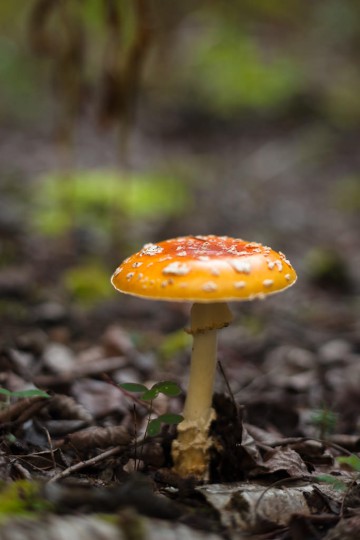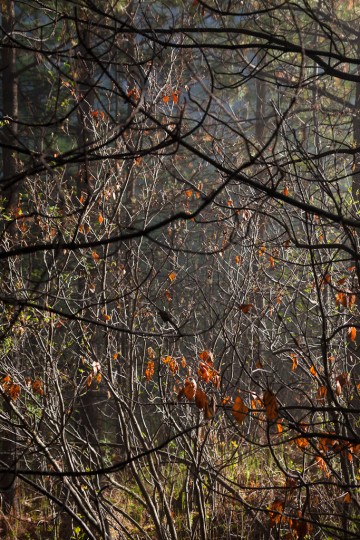 Fresh amanita mushroom Almost exactly two years ago (less one day), I had the opportunity to photograph a tremendous diversity of mushrooms at Ministik (click here to view a gallery of images). Today, I went back to the same spot and, while the diversity was much lower than the previous year, there were some great mushrooms out—and I had a great time photographing a few of them. This is a very fresh, still growing “Fly Agaric” or “Fly Amanita” mushroom (Amanita muscaria). Beautiful to look at—and photograph—but don’t eat it!
 me photographing mushroom For most of the morning, I used my 50mm f/1.4 and flipped the centre column of my tripod upside down to make low-angled, shallow depth-of-field photographs of these mushrooms. I see mushrooms like this often while doing field work, but rarely have the time to take deliberate, careful photos of them. I’ll share a couple more from this morning in the next little while, so please come back again soon. (Here’s a quick photo of my hard at “work” this morning…)
 First fall colour So, I’m back from my work in Fort McMurray, I’ve had a chance to rest up a bit, and I’m looking forward to resuming my project of making a new print every day. Just a simple print today from a photograph that I took early last September at the Ministik Game Bird Sanctuary. I’m headed out to Ministik tomorrow morning for the first time in a long while, and hope to come back with some new photographs that I can share here.
 Morning light in young pine stand This patch of forest was pretty much the opposite of the one in yesterday’s photograph—it was a thick, messy, second-growth tangle of young pine, alder, and other shrubs. But when the fog started burning off, and the first strong rays of sun started piercing through to the forest floor it was so beautiful, it almost made up for how soaking wet I was walking through it (and it smelled amazing too!)
Finding an interesting composition in the dense boreal understory is one of my favourite photographic challenges. If you’re interested in this photo, I have a portfolio of similar images entitled “Branches”. You can find it by clicking here, or following the navigation bar up top. Here’s the description that I wrote for that portfolio:
“There are times when I stop while walking through the dense understory common in the boreal forest and aspen parkland to admire the complex beauty of the entwined branches, willows, grasses, and leaves. Then I bring my camera up, and as I look through the lens the complexity turns to chaos as the lens compresses the scene onto a two-dimensional plane. This is when the challenge (and fun) begins. By moving the camera a few degrees to one side, changing the focal length by a few millimeters, or opening the aperture a few stops, a composition may be found that is balanced, pleasing to the eye, and captures some of the beauty entangled in these forests.”
 Old-growth aspen This was a gorgeous forest stand to work and photograph in, and, unfortunately, a bit of an oddity to find such large, old aspens left out on the landscape. My goal printing this image was to preserve the subtlety of tone and light & shadow, but still capture some of the brilliance of this stand in the early morning light.
 Colourful mixedwood trunks I’m writing this post as my printer churns away on this one, and I’m really interested to see how it turns out. I’ve often heard it recommended to push a given processing technique a little too far, and then ease back a little. By doing this, you discover the limit of the technique without crossing it. This sounds reasonable in practice, but I fear that you then have all your images at the edge of what’s acceptable, and perhaps sacrifice some subtlety. A certain subtley, is often harder to notice at the moment that you’re working on an image in Lightroom, but can easily be essential to making a good image a great image. I guess the goal is to be able to recognize when an image requires that subtlety, and to make sure that you’re not crossing that line.
So with that in mind, I picked this photo (which, although I quite like it, I don’t think is very subtle at all) and pushed the clarity and sharpness to the limit of what I thought looked good on my screen. Once the print is finished, it’ll be interesting to see how well (or not) that translated on to paper.
 Fresh rain on summer Tiger Lily This one is for my wife today.
 Tall dried grass I’m trying to print a wide range of photos as I start up on my Daily Print project to give myself a feel for what kinds of prints I’m fairly good at making already, and which areas I could use more practice.
I’m also trying to use a range of tools and techniques that I haven’t used before, to try to add them to my regular workflow to be used as required. This image showed just a hint of “green fringing” chromatic abberation, so I tried out Lightroom 4.1’s new “Defringe” controls. I don’t know if the slight fringing would have been noticeable in a print originally, but it sure wasn’t after a little bit of extra tweaking. Cool.
|
(Click photos to enlarge)
|









